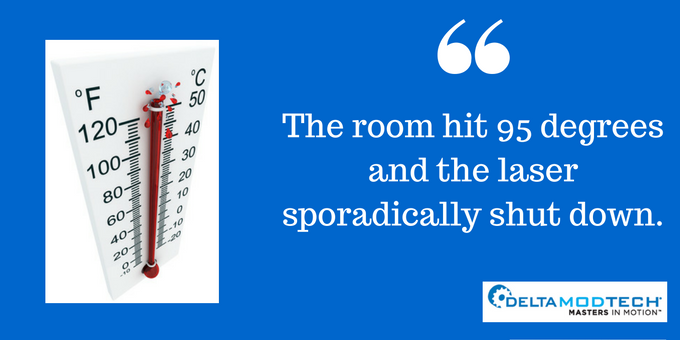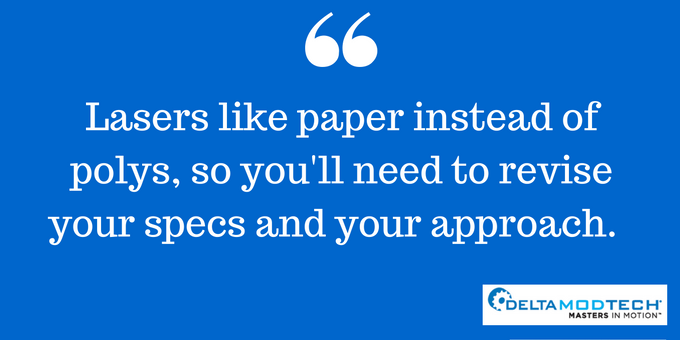
7 Things to Know Before Choosing a Laser Die Cutting Machine
A laser die cutting machine uses light instead of hard tooling and hard steel blades. As a result, your materials are going to react differently, and the by-product from the runs (smoke, particulates) require different installation requirements and ventilation.
We’ve already touched on what you should consider when choosing a laser die cutting vs. a rotary die cutting machine. Now let’s detail seven important items that are required in terms of safety, maintenance and ongoing operation with a laser die cutting machine.
1. Climate Control
A climate-controlled environment with low humidity is best for optimum laser stability. Lasers like to stay in an ambient temperature, because unlike metal tooling, the laser has some high-tech components inside the laser cavity that are more sensitivity to heat.

For example, we installed a laser in a small, enclosed room (30’x30’) with the chiller for the laser also inside the room. Within an hour the room warmed up to 95 degrees, and the laser sporadically shut down. (We subsequently moved the chiller outside the room, which solved the problem.)
We installed a similar system in a much more open facility where the ambient temperature can reach over 100 degrees during the summer, and the system is performing without failures.
Laser operation can become intermittent in temperatures above 100 degrees and catastrophic when the cooling fluid temperature is at or below the dew point of the air. The environment of the room should determine where the equipment will go (we’ll touch on that next), and what types of ventilation or humidity controls will be required for proper functionality.
2. Space/Utility Requirements
Laser machines typically utilize an external air-water chiller, which will have to be placed near the machine. The chiller unit will throw heat into the surrounding area, so you’ll need to consider exhausting hot air out of the building; hard-piping the plumbing for the unit; proper-sized water lines; and appropriate clearance around the chiller for functionality stability.
For slug collection, a laser machine may also require a slug collection drum. You’ll need ducting from the machine to the drum; from the drum to the blower; and from the blower to the outside. If the exhaust run to the outside is quite long, an additional assist blower may be needed.
3. Height Requirements

The height of a typical die cutting laser machine is approximately 10 feet. Ample height is not only required for installation, but also for ongoing service and maintenance
Lasers do not last forever. To ensure they have a long service life, yearly preventative maintenance is required. This requires ample space to access the laser components. The optimal height is about 4 feet above the top of the machine, otherwise it’s extremely difficult for a technician to maneuver and use equipment on the machine.
4. Preventative Maintenance
We touched on the need for an annual preventative maintenance (PM) program. An effective PM should include, at the minimum:
- Fluid changeover and filter replacement
- Pneumatic filter replacement
- Optic train inspection
- Cleaning, and alignment
- Laser health inspection
- Recalibration
Your OEM will typically conduct the maintenance. If you’re bidding on a machine, be sure to learn about each vendor’s respective maintenance program.
5. Laser Safety Officer
Lasers follow a classification system to indicate the level of potential hazard. Class 1 levels of radiation are not considered hazardous.
Many laser converting machines use a Class 4 laser that is guarded and interlocked to achieve Class 1 rating. They are self-contained, and no personal protective equipment is required. Operators don’t need safety glasses or special clothing.
OSHA doesn’t require a safety officer for systems with a Class 1 system, but to be on the safe side, designate one team member to understand the risks and educate the rest of the employees on the risks of laser operation. For example, if a safety officer were to spot a panel that wasn’t closed properly, they can report it to the OEM for maintenance.
6. Proficiency in CAD
Lasers rely on a CAD-based interface for the generation and manipulation of the artwork. You’ll need someone proficient in CAD to create the drawing, and then you can program it into the software for the laser die cutting machine. (Your OEM can help if you need assistance.)
7. Process Development
Laser die cutting is a completely different animal than conventional die cutting. For example, metal tooling works well with poly substrates, which means you can use materials with greater thickness. But with lasers, you are burning materials and the heat isn’t expelled.

More rigid materials are required so the web isn’t distorted. It requires a mind shift and materials change: Lasers like paper instead of polys, so you’ll need to revise your specs and your approach.
We’ll be detailing tips on how to use your laser die cutting machine for faster cutting, ideal cut widths, ideal materials and other best practices in an upcoming post. Be sure to subscribe to our blog in the box in the right-hand column to receive the post.
Don’t Plant Vines: Consult the Checklist Upfront
The architect Frank Lloyd Wright once said, “The physician can bury his mistakes, but the architect can only advise his client to plant vines.”
While Wright was referring to the permanence of buildings, the same can be said for an industrial laser die cutting machine within your facility. Only proper planning and consideration of the differences between laser and conventional die cutting machines will ensure effective long-term performance.
OVERCOME YOUR BIGGEST CONVERTING AND PACKAGING CHALLENGES
Published on Sep 13 2016
Categories: Delta ModTech Blog, Die Cutting, Lasers
Previous Post
6 Methods for Innovating in a Highly Technical Field

